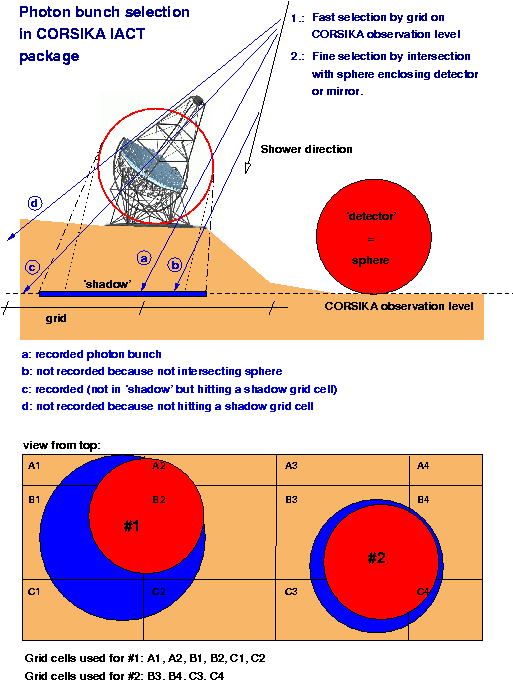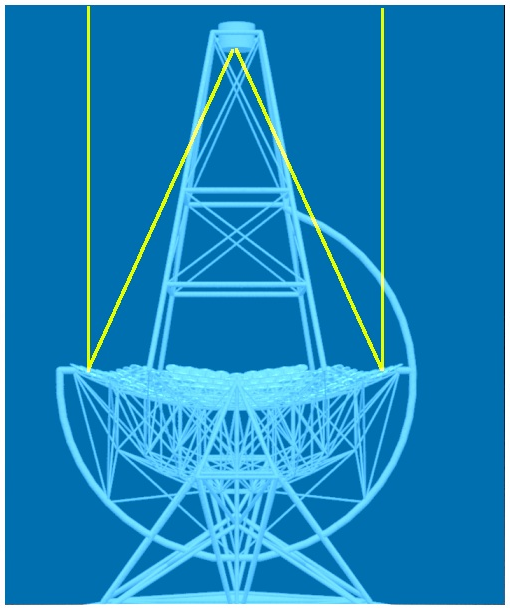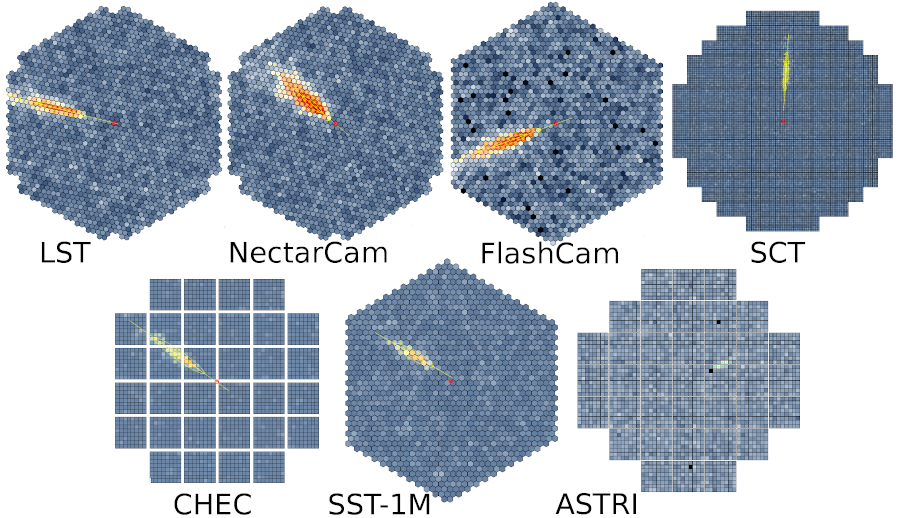





The sim_telarray code in general reads a complete set of photon bunches
for one simulated telescope, traces the photons through the complete
telescope optics (single reflection with spherical mirrors in Davies-Cotton
layout or parabolic or intermediate, or dual reflection with non-spherical
Schwarzschild-Couder optics) onto
a camera of round, quadratic, or hexagonal pixels, each consisting of a funnel
and a photomultiplier tube (PMT). Loss processes include atmospheric absorption,
shadowing by the camera body (explicit in ray-tracing) and camera masts
(implicit as a telescope transmission), mirror reflectivity,
gaps between pixels, transmission of
a pixel cover (if any), light collection by the funnel as an angle-dependent
efficiency and finally the quantum efficiency and collection efficiency of the PMT.
The ray-tracing includes imperfect mirror surfaces and random misalignements
of individual mirrors. It also takes into account that photons might be emitted
behind (after) the mirrors by particles hitting the telescope.
Each detected photo-electron (p.e.) is assumed to result in an analogue signal of identical shape but varying amplitude (according to the single photo-electron response, SPE). Actually several sets of shapes are used. One for the trigger decision as an input to a discriminator or comparator and another one or two for the signal to be digitized by ADCs or Flash-ADCs. Pixels may vary in their quantum efficiencies, high voltages needed for a given gain ,with corresponding variation in transit times, in threshold and so on.
The PMTs also register night-sky background (NSB) photons. To account for that, each pixel has a NSB photo-electron rate assigned (usually identical for all pixels, but can be different if so desired). In addition, stars can be added with the spot size as resulting from the ray-tracing through the telescope. For NSB photo-electrons, a slightly different SPE is applied to take afterpulses into account. Afterpulses may be significantly larger than the normal photo-electron response and can be ignored for the Cherenkov photons because of their delay (typically 500 ns) but a NSB p.e. released earlier might leed to an afterpulse at the time of the Cherenkov flash.
After the trigger decision has been made and digitized signals have been simulated, for all telescopes in an array, the system trigger is simulated as well. After that, the results of the simulation together with optional shower reconstruction are written into an output file which closely follows the format for experimental data, except for additional blocks representing `true' parameters in the simulation.
The resulting data files can be processed as-is with code in the 'hessioxxx' package (see below), converted into the native formats of other Cherenkov telescope data analysis packages, including those in use within the H.E.S.S., MAGIC, and VERITAS collaborations. It can also be read and processed directly with the ctapipe data-processing framework under development for CTA.
Report problems to Konrad . Bernloehr (at) mpi-hd . mpg . de
Name Last modified Size Description
ChangeLog 2025-02-20 20:44 475K
Copyright 2025-02-20 22:12 1.7K
Documentation/ 2024-03-15 12:11 -
ForPublishedConfigs/ 2024-11-22 15:27 -
Licence/ 2020-04-19 19:05 -
Papers/ 2021-12-16 12:26 -
Presentations/ 2020-04-19 19:05 -
Tutorial/ 2020-04-19 19:06 -
build_all 2025-02-20 20:52 58K
clean_all 2024-03-20 15:36 6.2K
cta-cameras_small.png 2020-02-04 20:43 588K PNG image
examples-with-data_minimal.tar.gz 2021-12-25 21:39 663K gzip compressed document
hessioxxx.tar.gz 2025-02-20 20:42 4.3M gzip compressed document
iact3d.png 2012-10-09 18:15 35K PNG image
raytel.png 2020-02-07 14:34 239K PNG image
sim_telarray.tar.gz 2025-02-20 20:45 16M gzip compressed document
sim_telarray_config_common.tar.gz 2025-02-20 20:45 6.9M gzip compressed document
sim_telarray_config_hess_minimal.tar.gz 2025-02-20 20:45 269K gzip compressed document
stdtools.tar.gz 2025-02-04 17:47 50K gzip compressed document